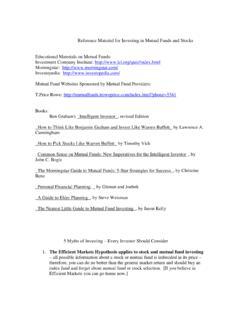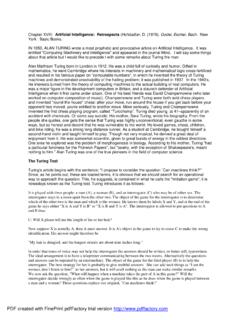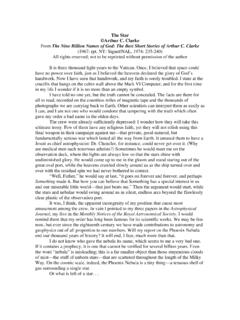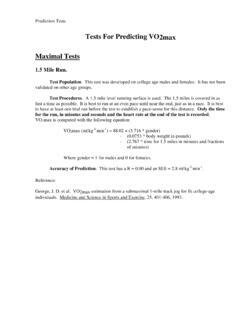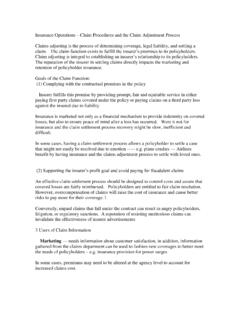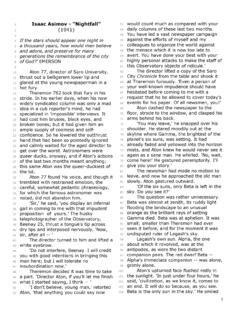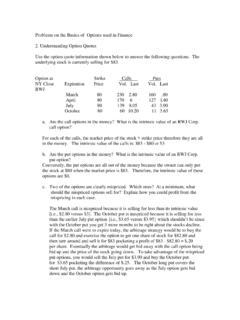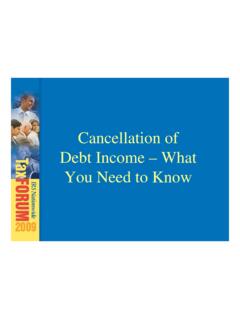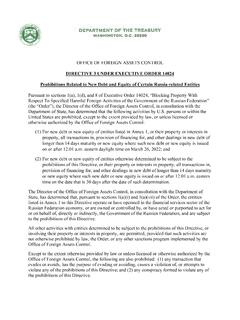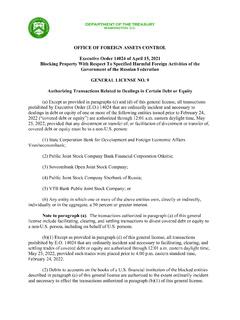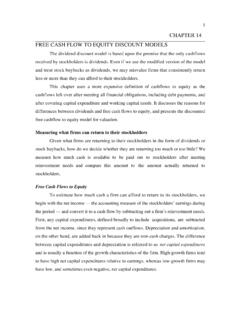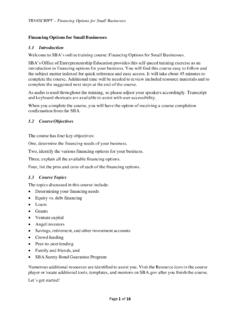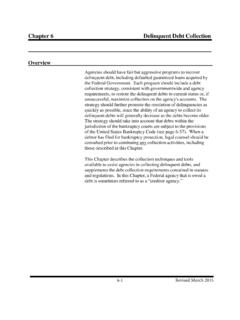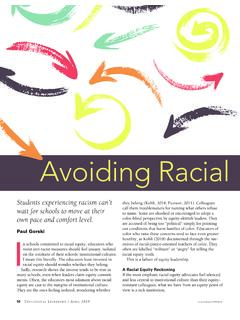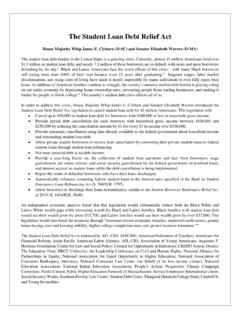Transcription of Problems Relating to Capital Structure and Leverage 1. EBIT …
1 Problems Relating to Capital Structure and Leverage 1. EBIT and Leverage Money Inc., has no debt outstanding and a total market value of $150,000. Earnings before interest and taxes [EBIT] are projected to be $14,000 if economic conditions are normal. If there is a strong expansion in the economy, then EBIT will be 30% higher. If there is a recession, then EBIT will be 60% lower. Money is considering a $60,000 debt issue with a 5% interest rate. The proceeds will be used to repurchase shares of stock. There are currently 2,500 shares outstanding. Ignore taxes for this problem. a. Calculate earnings per share [EPS] under each of the three economic scenarios before any debt is issued. Also calculate the % changes in EPS when the economy expands or enters a recession. If you ignore taxes in this problem and there is no debt outstanding: Under Normal Economic Conditions EPS = EBIT/shares outstanding = $14,000/2,500 = $ Under Expansionary Times: EPS = [EBIT x ]/shares outstanding = $14,000( )/2,500 $18,200/2,500 = $ Under a Recession: EPS = [EBIT x ( )]/shares outstanding =$14,000(.)
2 40)/2,500 $5,600/2,500 = $ % EPS going from Normal Expansion: ($ - $ )/$ = .30 or 30% % EPS going from Normal Recession: ($ - $ )/$ = or -60% b. Repeat part (a) assuming that Money goes through with recapitalization. What do you observe? If the market value of the firm is $150,000 with 2,500 shares outstanding, then the value of one share of stock is: $150,000/2,500 = $60/share. If $60,000 worth of debt is raised to retire stock, then you will be buying back $60,000/$60 or 1,000 shares. So, after recapitalization there will be 2,500 -1,000 or 1,500 shares outstanding. EBIT will be reduced by the amount of the interest on $60,000 in debt or $60,000 x .05 = $3,000. Recession Normal Expansion EBIT $5,600 $14,000 $18,200 Less: Interest 3,000 3,000 3,000 EBT=NI $2,600 $11,000 $15,200 EPS $ $ $ Normal Conditions: EPS = $11,000/1,500 = $ Expansionary Times: EPS = $15,200/1,500 = $ % EPS going from Normal Expansion: ($ - $ )/$ =.
3 38199 or Normal Conditions: EPS = $11,000/1,500 = $ Recession: EPS = $2,600/1,500 = $ % EPS going from Normal Recession: ($ - $ )/$ = . or The use of debt to buy back shares will cause a dramatic increase in EPS should the economy stay normal or move to an expansionary state. On the other hand, if the economy goes into a recession the Leverage will cause EPS to decline by a much greater % than the increase due to expansion. The firm would also need to consider the market price of its stock [whether it is on sale], the prospects for earnings even in the event of a recession [ , does the firm produce a product or service that everyone needs [somewhat inelastic good/service]], and whether the financing rate is attractive [spread between the interest rate on debt and the return on equity ]. ROE and Leverage 3. Suppose the company in Problem 1 has a market-to-book ratio of a. Calculate return on equity [ROE], under each of the 3 economic scenarios before any debt is issued.
4 Also calculate the % in ROE for economic expansion and recession, assuming no taxes. Since the firm has a market-to-book value of , the total equity of the firm is equal to the market value of equity . ROE = NI/E = NI/$150,000 The ROE for each state of the economy under the current Capital Structure and no taxes is: Recession Normal Expansion ROE $5,600/$150,000 $14,000/$150,000 $18,200/$150,000 ROE .0373 .0933 .1213 Sensitivity Analysis: Normal to Recession % ROE = (.0373 - .0933)/.0933 = or -60% Sensitivity Analysis: Normal to Expansion % ROE = (.1213 - .0933)/.0933 = .3001 or 30% b. Repeat part (a) assuming the firm goes through with the recapitalization. Assuming no taxes, interest on debt of 5%. If the firm goes forward with recapitalization, the new equity value will be: equity = $150,000 - $60,000 or $90,000 [due to reduction of shares outstanding] So, the ROE for each state of the economy is: ROE = NI/$90,000 Recession Normal Expansion ROE $2,600/$90,000 $11,000/$90,000 $15,200/$90,000 ROE.
5 0289 .1222 .1689 Sensitivity Analysis: Normal to Recession % ROE = (.0289 - .1222)/.1222 = or Sensitivity Analysis: Normal to Expansion % ROE = (.1689 - .1222)/.1222 = .3822 or c. Repeat parts (a) and (b) of this problem considering the fact that the Company has a 35% tax rate. Recession Normal Expansion EBIT $ 5,600 $ 14,000 $ 18,200 Less: Interest 3,000 3,000 3,000 EBT $ 2,600 $ 11,000 $ 15,200 Less: Taxes @ 35% 910 3,850 5,320 NI $ 1,690 $ 7,150 $ 9,880 ROE .01877 .07944 .10977 Sensitivity Analysis: Normal to Recession % ROE = (.)
6 01877 - ..07944)/.07944 = or Sensitivity Analysis: Normal to Expansion % ROE = (.10977 - .07944)/.07944 = .3818 or The % ROE is the same as the % EPS, and also the % ROE remains the same regardless of taxes [ , the tax rate has an equal impact on NI for all states of the economy]. 12. Calculating WACC Weston Industries has a debt - equity ratio of Its WACC is 12%, and its cost of debt is 12%. The corporate tax rate is 35%. a. What is Weston s cost of equity Capital . Compute the weights on the various sources of financing D/E = D = E, so D/[D+E] = [ + E] = = .6 or 60% E/[D+E] = 1 - .60 = .4 or 40% Therefore, WACC = .6 x .12 x + .4 ke .12 = .0468 + . 4 ke .0732/.4 = ke .183 = ke 12. b. What is Weston s unlevered cost of equity Capital ? To find the unlevered cost of equity we use the M&M Proposition 2 with taxes: ke = kul + [kul - kD] [D/E] [1 t].
7 183 = kul + [kul - .12] [ ] [1 .35] .183 = kul + .975 kul - .117 .30 = kul .15189 or = kul c. What would the cost of equity be if the debt -to- equity ratio were 2 instead of { , more debt relative to equity higher Leverage }? What if it were instead of { , more debt relative to equity less Leverage }? Using the information and the same methodology as in (b) with the M&M Proposition 2: With the D/E = 2 ke = kul + [kul - kD] [D/E] [1 t] ke = kul + [kul - .12] [D/E] [1 .35] ke = .1519 + [.1519 - .12] [ ] [1 .35] = .19337 or With the D/E = 1 ke = kul + [kul - kD] [D/E] [1 t] ke = kul + [kul - .12] [D/E] [1 .35] ke = .1519 + [.1519 - .12] [ ] [1 .35] = ..1726 or If the D/E = 0 then ke = kul = [ , there is no Leverage to consider] 18. Firm Value Old School Corporation expects an EBIT of $9,000 every year forever. Old School currently has no debt , and its cost of equity is 17%.
8 The firm can borrow at 10%. If the corporate tax rate is 35%, what is the value of the firm? What will be the value of Old School if it converts to 50% debt ? To 100% debt ? With no debt , we are basically finding the value of the unlevered firm. VUL = EBIT [1-t]/kul = $9,000(.65)/.17 = $5,850/.17 = $34, With debt , we simply need to use the equation for the value of a levered firm. With 50% debt , half of the firm s value is tied up in debt , so the value of the firm is: V = VUL + Tax rate x B { debt } = $34, + .35 x ($34, ) V = $34, + $6, = $40, With 100% debt , the value of the firm is: V = $34, + .35($34, ) = ( )($34, ) = $46, Note: It is very unlikely anyone would extend 100% debt financing to the firm given the Leverage , but if they did, it would be tantamount to owning their owning the company. In addition, the IRS would probably consider the deal more of a purchase and therefore seek to disallow the interest expense deductions on the debt .
9 21, Cost of Capital Acetate, Inc. has equity with a market value of $20 million and debt with a market value of $10 million. Treasury bills that mature in one year yield 8% per year, and the expected return on the market portfolio over the next year is 18%. The beta of Acetate s equity is .90. The firm pays no taxes. a. What is Acetate s debt to equity ratio? debt / equity = MVD / MVE = $10 million/$ 20 million = .50 b. What is Acetate s weighted average cost of Capital ? First, we need to calculate the cost of equity . Ke = Krf + [KM - Krf] = .08 + .90 [.18 - .08] = .17 or 17% We need to remember that one of the MM assumptions is that the firm s debt is risk-free, so we can use the Treasury bill rate as the cost of debt for the company. In the absence of taxes, a firm s weighted average cost of Capital is equal to: RWAAC = [D/[D+E]]KD + [E/[D + E]]Ke RWAAC = [$10 million/$30 million](.08) + [$20 million/$30 million](.17) RWAAC = .14 or 14% So, the WAAC is a blended rate based on the relative proportion of debt to equity financing, ignoring tax effects.
10 C. What is the cost of Capital for an otherwise identical all- equity firm? According to MM Proposition 2 with no taxes: RE = RUL + [D/E] [RUL RD] .17 = RUL + [.5] [RUL .08] RUL = .14 or 14% This result is consistent with MM s proposition that, in the absence of taxes, the cost of Capital for an all- equity firm is equal to the weighted average cost of Capital for an otherwise identical levered firm. 22. Homeade Leverage The Veblen Company and the Knight Company are identical in every respect except that Veblen is not levered. The market value of Knight Company s 6% bonds is $1 million. Financial information for the two firms appears here. All earnings streams are perpetuities. Neither firm pays taxes. Both firms distribute all earnings available to common stockholders immediately. Veblen Knight Projected operating income $ 300,000 $ 300,000 Year-end Interest on debt ---------- 60,000 Market Value of Stock $2,400,000 $1,714,000 Market Value of debt ----------- $1,000,000 a.

